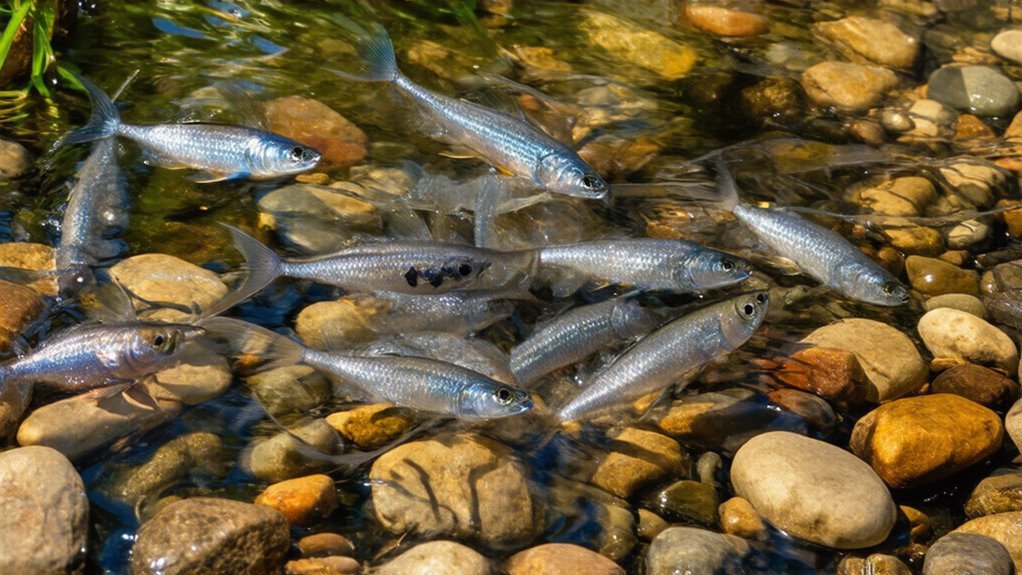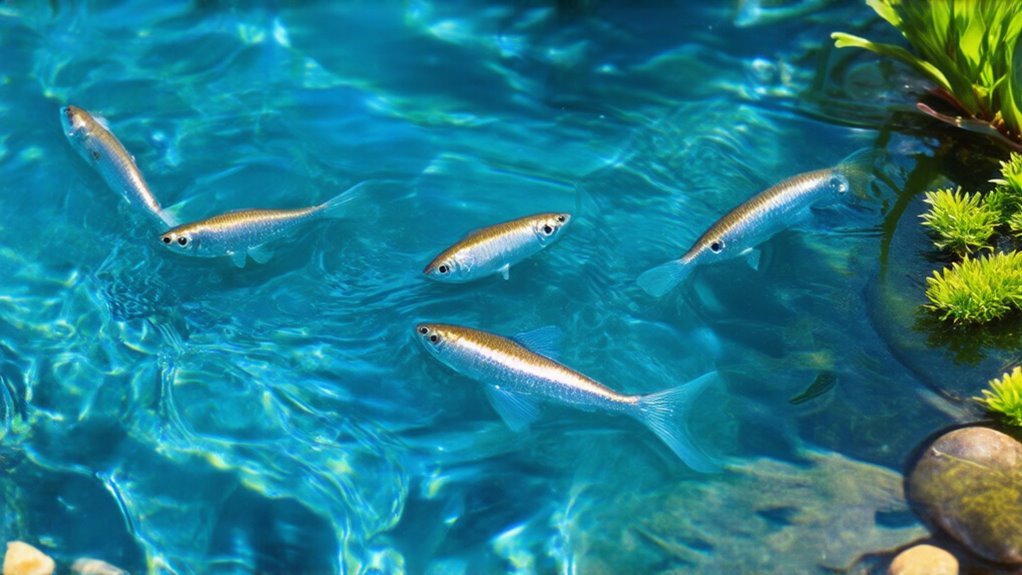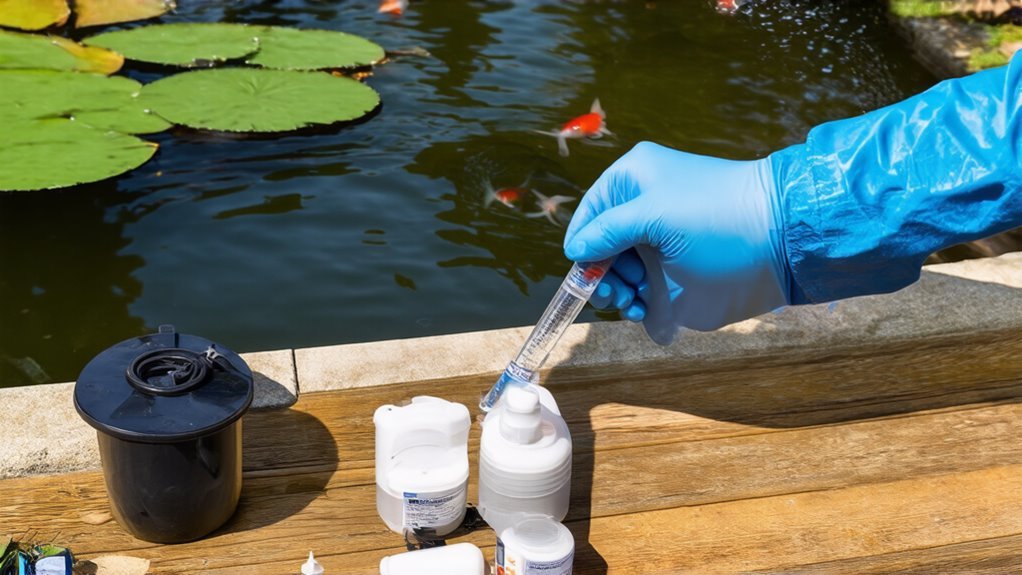Minnows aren’t just bait—they’re a nutritional powerhouse hiding in plain sight. They’re packed with omega-3s and can be prepared in countless ways, from Japanese tempura to Mediterranean salt-curing techniques. While many people turn up their noses at these tiny fish, cultures around the world have celebrated them for centuries. The secret to truly appreciating minnows lies in understanding which species are best for the table and how to handle them properly.
What Are True Minnows? Identifying Edible Species

Confusion reigns when it comes to minnows, with many people incorrectly identifying several small fish species as members of this family.
True minnows actually belong to the Cyprinidae and Leuciscidae families, not to be confused with topminnows, mudminnows, or killifish which, despite their names, aren’t true minnows at all.
Identifying true minnows requires precision—they’re strictly Cyprinidae and Leuciscidae family members, not the similarly-named imposters that swim nearby.
When identifying edible varieties, look for common species like the fathead minnow, common shiner, lake chub, central stoneroller, and golden shiner.
These typically max out at 4 inches or less. They’re safe to eat when caught from clean waters, though their small size makes filleting challenging.
Most folks eat them whole—tiny bones and all.
Nutritional Profile: Health Benefits of Consuming Minnows

Beyond their tiny size, minnows pack a surprising nutritional punch that’s worth considering for your diet.
They’re rich in omega-3 fatty acids, which come from their diverse diet of algae and plankton. Unlike what some health myths suggest, these small fish aren’t just “empty calories” – they actually offer a nutritional comparison similar to larger fish species.
You’ll find they’re loaded with protein, essential vitamins like B12, and minerals such as calcium (especially when consumed whole with bones).
Well, I think they’re particularly beneficial for those seeking sustainable protein sources that don’t break the bank.
Safety First: Water Quality and Proper Handling

Although minnows are nutritious, where you catch them matters greatly for your health and safety. Never harvest from waters near industrial areas, farms, or city runoff—these often contain harmful pollutants. Basic water testing kits can help determine if a location is safe. It’s crucial to ensure that the water is free from harmful pollutants to protect your health.
When handling minnows, follow proper precautions. Wash your hands before and after catching them, and keep them on ice immediately. They spoil quickly! You’ll want to gut them promptly, especially in warm weather. Honestly, the handling precautions aren’t complicated, but they’re essential for preventing foodborne illness. Clean water means clean fish!
The Art of Catching Your Own Minnows
Now that you know how to handle minnows safely, let’s talk about catching them.
Ready to move beyond handling? Let’s explore how to actually catch those elusive minnows.
It’s surprisingly easy with the right fishing gear. Near-shore fish traps work best—you can buy one or make your own with a plastic bottle.
For bait types, you’ve got options. Breadcrumbs are my go-to, but live worms, shellfish pieces, or even other minnows work great too.
Early morning fishing yields the best results, I think.
You can also try the old-fashioned way—actually striking the water to stun them.
Though, well, that requires more practice than using traps.
Traditional Preparation Methods Around the World
While many people overlook minnows as mere bait fish, these tiny swimmers have been prepared as food in diverse cultures for centuries. Their cultural significance extends across global cuisines, from Asian street food markets to European fishing communities.
| Region | Preparation Method | Cultural Notes |
|---|---|---|
| Japan | Tempura-style | Often served with sake |
| Mediterranean | Salt-cured | Family recipes passed down generations |
| North America | Smoked or dried | Traditional Native American preservation |
What’s interesting about minnow preparation is how similar techniques evolved independently across continents. In many fishing villages, they’re not just sustenance but represent resourcefulness and respect for nature’s bounty. They’re typically eaten whole, bones and all!
Modern Culinary Techniques for Minnow Dishes
Beyond traditional methods, today’s innovative culinary techniques have transformed minnows from humble bait fish to surprisingly sophisticated ingredients in contemporary cuisine.
Chefs are exploring sous vide preparations, where these delicate fish are vacuum-sealed with herbs and oils, then cooked at precise low temperatures to maintain moisture and enhance their subtle flavors.
Flavor infusion techniques have also gained popularity, with minnows being marinated in citrus, herbs, or even smoked tea before cooking.
They’re appearing in upscale restaurants as garnishes for soups, incorporated into seafood mousses, or flash-fried and served as gourmet bar snacks with creative dipping sauces.
Sustainable Harvesting: Environmental Considerations
As our appetite for seafood continues to grow, the sustainable harvesting of minnows deserves careful consideration from both recreational anglers and commercial fishers.
When collected responsibly, these small fish can be a renewable food source with minimal ecological impact.
To guarantee sustainable practices, follow these guidelines:
Embrace responsible harvesting to ensure minnows remain plentiful for generations of fishers and ecosystems alike.
- Harvest only what you’ll eat – avoid taking more than needed
- Release breeding females during spawning season
- Rotate collection areas to prevent localized depletion
- Check local regulations before harvesting
Actually, I think the most important thing is understanding that minnows serve essential roles in their ecosystems. They’re not just food for us, but critical links in the aquatic food chain, which highlights their importance in maintaining ecological balance.
Frequently Asked Questions
Can Minnows Be Farmed Commercially for Human Consumption?
Minnows can be farmed commercially for human consumption. Minnow farming offers commercial viability due to their protein content, though their small size presents challenges compared to larger fish species.
How Do Minnows Compare Nutritionally to Other Small Fish Like Anchovies?
Minnows offer similar protein content to anchovies but with potentially higher omega-3 fatty acids. They’re typically less salty with minnow benefits including diverse nutrients absorbed from their varied diet, making fish comparisons favorable.
Are There Any Religious or Cultural Restrictions Around Eating Minnows?
Religious beliefs don’t specifically target minnows, but some cultural practices limit consumption of fish without fins and scales. Many traditions don’t address minnows directly in their dietary restrictions.
Can Children and Pregnant Women Safely Consume Minnows?
Like steering through murky waters, safety for children and pregnant women depends on health guidelines. They can consume properly cooked minnows from clean waters following safe preparation to avoid pathogens and potential contaminants.
How Long Can Minnows Be Stored After Catching Before Cooking?
Freshly caught minnows should be consumed within 24-48 hours if refrigerated. Storage methods include ice-packing or refrigeration. Freshness indicators include clear eyes, firm flesh, and absence of strong odors.

